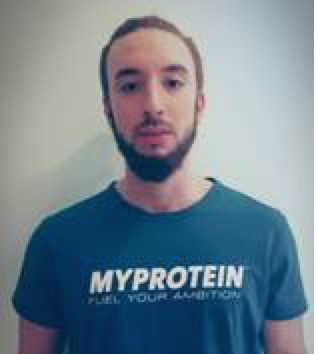
Ο Γιώργος Γιαννικέλης είναι αρθρογράφος και συνεργάτης της εταιρείας Myprotein τα τελευταία 2,5 χρόνια. Διαθέτει Bachelor of Science (Β.Sc.) στο κομμάτι της Φυσικής Αγωγής και Προπονητικής από το Γαλλικό Πανεπιστήμιο του Στρασβούργου, ετοιμάζεται για το μεταπτυχιακό του στην Αθλητική Διατροφολογία. Η διπλωματική του εργασία ήταν πάνω στις επιδράσεις του εκ της ασκήσεως προερχόμενου οξειδωτικού στρες στους κυτταρικούς μηχανισμούς και την παραγωγή μυϊκής δύναμης. Έχει παρακολουθήσει διάφορα σεμινάρια σχετικά με το bodybuilding, την διατροφή και την υγεία και την δεδομένη στιγμή κάνει προσωπικές προπονήσεις σε άτομα που ενδιαφέρουν να αλλάξουν την σωματική τους σύσταση και να βελτιώσουν τις αθλητικές τους επιδόσεις.
Ο Γιώργος έχει αρθρογραφήσει για θέματα bodybuilding και fitness σε ελληνικές ιστοστελίδες, όπως το ifitnessbook.com http://www.ifitnessbook.com/ σχετικά με την αθλητική επιστήμη και τον υγιεινό τρόπο διατροφής.
Ασχολείται με την παροχή υπηρεσιών προσωπικής εκγύμνασης (personal training) και εξειδικευμένων ατομικών συμβουλών διατροφής και υγείας, καθώς επίσης και από πολυετή προσωπική καθημερινή μελέτη επιστημονικών ερευνών, αρθρών και βιβλίων αξιομένων επιστημόνων του εξωτερικού σε όλο το φάσμα των βιο‐επιστημών που διέπουν την άσκηση και την υγεία.
Μπορείτε να δείτε περισσότερα σχετικά με τον Γιώργο εδώ : https://www.linkedin.com/in/george‐giannikelis‐133baa16a/
Στον ελεύθερο του χρόνο του αρέσει να ασχολείται με την μαγειρική, την μουσική και την ανθρώπινη ψυχολογία. Πιστεύει ακράδαντα στο ρητό «Νους υγιής εν σώματι υγιεί».
















